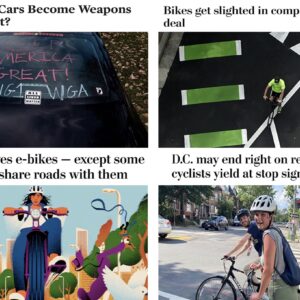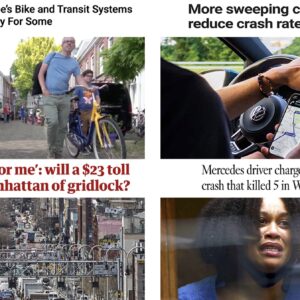Placing the blame; Russell Crowe; Green Impact Zone; lawfully running reds; Google’s next big thing; carfree campus; competing one-way streets
Here’s the last week in news, rounded up after the long weekend.
– The electric car money is landing; Swiss battery company ReVolt is planning to open its North American headquarters in Portland. Here’s an in-depth look at the electric car stimulus program from Seattle, which is also a test city. And Time Magazine discusses the future of “zero emissions” cars.
– If you kill someone with your car while texting in Utah, you can now get up to 15 years in prison. In Wales, a gory video warns teens of the dangers of intextication.
– Depending on your perspective, one of the most and least attractive aspects of urban light rail is the way it boosts property values. A case study outlines some of the discussions and dilemmas around affordable housing as Atlanta, Georgia plans for a new train system.
– NPR has a story on the need for multimodal connections at either end of a long-distance train trip.
– Four blocks of N Denver St in Portland’s Kenton neighborhood are set to become the city’s first full-fledged “green street,” including wider sidewalks and bike lanes, calmed traffic, benches, greenery, and — the main point of the project — improved stormwater management.
– Kansas City, Missouri is creating a “green impact zone” in its central city, featuring a variety of initiatives from bike infrastructure to home weatherization.
– Also in Missouri, a new state law allows people on bicycles and motorcycles to proceed through a red light after stopping if their vehicle doesn’t set off the trigger that changes the light.
– Chris Smith thinks Portland is entering its “second age of bicycle infrastructure.”
– CTV has an interesting roundup of bicycle infrastructure initiatives in Canadian cities.
– Quick update on the newly carfree Times Square — people dress strangely and sit around in lounge chairs, while the rest of midtown traffic flows better.
– Who’s legally at fault in bike-car crashes? In response to a well-publicized Toronto study said that 90% are caused by the person driving the car, Joe Rose at the O ran the local numbers and found it’s probably about 50/50 in Portland.
– Zipcar is starting to put bike racks on some vehicles in its Portland fleet.
– McGill University in Canada is planning to make much of its campus carfree by next year.
– Russell Crowe was ridiculed by a reporter for smoking cigarettes and drinking soda while on a bike ride; in response he challenged her to a race through Sydney, which he won handily and followed up with another smoke.
– Google is working out a scheme to feed real-time, crowdsourced traffic maps to your mobile device.
– Bikes are a popular tool for direct action and protests — here’s why.
– Finally, this tale of competing one way streets is priceless.




Thanks for reading.
BikePortland has served this community with independent community journalism since 2005. We rely on subscriptions from readers like you to survive. Your financial support is vital in keeping this valuable resource alive and well.
Please subscribe today to strengthen and expand our work.
Elly, Jonathan:
just a brief note of thanks for the news roundups. They are a fine, interesting and usually good-humored way to start one’s day.
Happy riding (wet and all)
P
I moved to PDX from Atlanta less than 2 years ago. Atlanta has completely mismanaged the Beltline project from the start. In Atlanta it’s all about the developers and how much money is going to change hands, politicians included.
+1, PatrickZ!!
I love the Monday Morning Round-up. Thanks, Elly and Jonathan, it makes the beginning of the week a bit easier.
That video from Wales freaked me out. I sent it to my mother, who is 60, but still texts while driving. It’s not just for teens!
Glad you like the news roundup — thanks for the props. Happy riding to you all —
It’s legal most anywhere to proceed through a red light not responding to a bike or motorcycle. A malfunctioning red light is treated as a stop sign. The key to avoid a ticket, however, it so wait through a complete cycle. As if everyone knows what that cycle may be…
Has the PBOT released the results of their July 09 bicycle trip study yet?
I’ve seen the same numbers (8% commute by bike; 4% total trips) used in many blog entries for some time now. It’s obvious to me, a regular rider, that bike traffic is up from last year. That 8%/4% number is from ’08, isn’t it?
http://blog.oregonlive.com/commuting/2009/09/when_motorists_cyclists_collid.html#5033208
Schrauf, it’s easy to figure out a particular light’s cycle.
Say you pull up to the intersection just when the light turns red. You wait through the cross traffic’s green. Then you wait through the oncoming traffic’s green. And then you sit through the cross traffic’s green again– which means that you got skipped. Proceed when safe to do so. I’d recommend going on the oncoming traffic’s green, or going over and hitting the crosswalk button.
As a rule of thumb, the Bike Manual as printed by the OR DMV says that you should wait through one light cycle or three minutes– as 99% of the light cycles here in Oregon are less than 3 minutes.
Hope this helps!! 🙂 (And yeah, who wants to sit at a red light for 3 minutes?! Yikes.)
“It’s legal most anywhere to proceed through a red light not responding to a bike or motorcycle.”
I’ve done this a time or two when I have been waiting in a straight/left turn lane and the light doesn’t change. I usually go either when the intersection is clear for a quarter mile in every direction, or on the oncoming straight/left signal. My fear is that I will someday be observed from afar by law enforcement who will tell me I should have dismounted and walked over to the pedestrian signal button and waited to cross on foot–then proceed to write me a $200.00 ticket for failure to obey a traffic control device. My inclination would then be to ask whether he would tell a motorist to do that if the signal were broken, but then I might get arrested…
I love the Russell Crowe story – priceless!
“the dangers of intexication”-
Is that the danger of living in Texas?
The reason that trains make land more valuable is because they make it better. The trick is to stop artificially restricting the supply of good urban spaces that are served by transit. Then we can all afford to live in them.
Great roundup as usual … one point of clarification. The Toronto study says nothing about 90 percent, that’s a New York study conflated with the Toronto findings. And the NY study got 90 percent from merging pedestrian fatalities with cycling stats. Cycling only was around 70 percent. More in “When an error goes viral” on my blog.